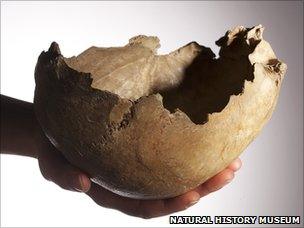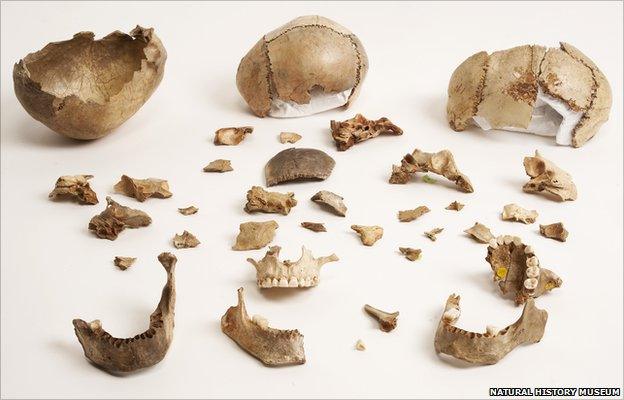Ancient Britons 'drank from skulls'
- Published

The level of modification suggests the ancient Britons were "manufacturing" something of use
Ancient Britons were not averse to using human skulls as drinking cups, skeletal remains unearthed in southwest England suggest.
The braincases from three individuals were fashioned in such a meticulous way that their use as bowls to hold liquid seems the only reasonable explanation.
The 14,700-year-old objects were discovered in Gough's Cave, Somerset.
Scientists from London's Natural History Museum, external say the skull-cups were probably used in some kind of ritual.
"If you look around the world there are examples of skull-cups in more recent times - in Tibetan culture, in Fiji in Oceania, and in India," said Dr Silvia Bello, a palaeontologist and lead author of a scientific paper on the subject in the journal PLoS One, external.
"So, skulls have been used as drinking bowls, and because of the similarity of the Gough's Cave skulls to these other examples, we imagine that that's what these ancient people were using them for also," she told BBC News.
Gough's Cave is situated in the Cheddar Gorge, a deep limestone canyon on the southern edge of the Mendip Hills.
Palaeo-investigations started there a hundred years ago, with many of the finds now held at the Natural History Museum (NHM).
The site is particularly noteworthy for the discovery in 1903 of "Cheddar Man", the complete skeleton of a male individual dating to about 10,000 years ago.
But the users - and owners - of the skulls discussed in the PLoS One article are actually from an earlier period in the history of the British Isles.
Dr Silvia Bello explains why it is thought the skulls were used as drinking vessels
This was during a brief warm spike in a series of ice ages that allowed humans living in southern Europe to venture north into what was otherwise an utterly inhospitable landscape.
These Cro-Magnons, as we now call them, were hunter-gatherers living on their wits and, it seems, eating human flesh when the need and opportunity arose.
Gough's Cave famously held the remains of human bones that had been butchered to extract marrow in exactly the same way as animal bones on the site had been processed.
Our modern sensibilities find the thought of cannibalism repulsive, but these people lived in a different age, Dr Bello said:
"They were a one man band; they were going out, hunting, butchering and then eating their kill. And they were extremely skilled at what they did, but then that's how they survived.
"I think the production of the skull-cups is ritualistic. If the purpose was simply to break the skulls to extract the brain to eat it, there are much easier ways to do that.
"If food was the objective, the skull would be highly fragmented. But here you can really see they tried to preserve most of the skull bone; the cut marks tell us they tried to clean the skull, taking off every piece of soft tissue so that they could then modify it very precisely. They were manufacturing something."

The scientists have three skull-cup specimens in their collection from Gough's Cave
NHM colleague Professor Chris Stringer helped excavate one of the skull-cups in 1987 and is a co-author on the paper.
"We've known that these bones were treated in this way for 20 years; it's been evident that there were cut marks on the skulls," he told BBC News.
"But by applying the latest microscopic techniques and the experience we've got in working on butchered animal remains, as well as human remains, we can start to build up a much more detailed picture of how the Gough's Cave remains were treated. Yes, cannibalism is the most likely explanation. What we can't say is whether these people were killed to be eaten, or whether they died naturally. Were they even members of the same group?"
And precisely how the cups were used cannot be known with total confidence either, although in more recent examples of such practice they have held blood, wine and food during rituals.
At about 14,700 years old, the Gough's Cave skull-cups would represent the oldest, recognised examples in the world.
The museum plans to put a detailed model of one of the skull-cups on display this March so that visitors can get a deeper insight the practices of these ancient Britons.
- Published7 July 2010